Hairballs 101: How to Reduce Hairballs in Cats
Posted: 11/06/2023 | BY: Erin Cain | Categories: Uncategorized
Does your cat regularly cough up hairballs? If so, you’re not alone. Trichobezoars are a common problem for cats, but there are ways to reduce their frequency. In this article, we will discuss the causes of this common occurrence and the available options to reduce or prevent this condition in our feline friends. We will also cover some tips for dealing with hairballs when they do occur. Read on for some helpful advice about ways to minimize hairballs in your cat.
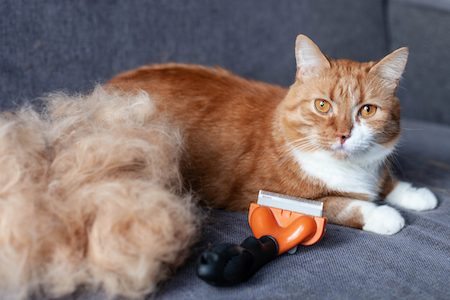
What are hairballs?
After your cat grooms their fur, they may regurgitate small, compacted clumps of hair that have been ingested and collected inside the stomach. These so-called “hairballs” can form when the cat doesn’t pass these hairs through its digestive system. They’re tube-shaped and are usually full of slimy fur.
How does so much hair get into a cat’s digestive tract? A cat’s tongue is covered in tiny hook-like structures, called papillae, and they help scoop up loose hair from the cat’s coat during the grooming process and swallow it. The hair, made of keratin, isn’t digestible for mammals, so most of the hair cats lick ends up passed along unprocessed in the stool or thrown up. Because cats spend 30 – 50% of their daily life grooming themselves, hairballs are a regular and expected part of sharing a home with a domestic feline friend.
Hairballs are often vomited up by themselves or alongside partially digested foods. Sometimes, hairballs are eliminated through the cat’s feces, preventing your kitty from digesting food properly. In severe cases, hairballs can cause potentially dangerous obstructions within the digestive system. Surgery is typically required to resolve these severe obstructions.
It is not uncommon for a cat to have one or two hairballs a week. Cat hairballs that occur more regularly may be a sign of blockage or other serious medical conditions.

What causes hairballs in cats?
Hairballs are a common problem for cats, but the cause can be traced back to one thing: hair ingestion. Suppose a cat swallows and ingests too much loose and dead hair from grooming herself or other cats. In that case, she may develop an accumulation of hair that causes problems in their stomach. Eventually, the discomfort of the hairball causes the cat to vomit it up. Other circumstances can increase the amount of fur a cat ingests, causing hairballs. Here are some causes of this condition:
- Allergies – If your cat is experiencing excessive itching or inflamed skin due to allergies, hairballs are more likely.
- Skin diseases or disorders – When cats groom themselves, it is not always because they have allergies. Other skin issues like cancer, infections, or parasites could lead them to ingest more hair than usual, leading hairballs to form.
- Digestive illnesses and diseases – Problems like intestinal cancers, tumors, and inflammatory diseases can contribute to excess grooming. Self-grooming is a soothing mechanism that cats may use to relieve stress and anxiety from physical or emotional discomfort.
- Excessive self-grooming – Grooming is an essential part of a cat’s life. Unfortunately, some cats go overboard with their grooming habits due to overwhelming stress or illness. As a result, these cats experience a higher number of hairballs. Too much self-grooming can be especially problematic for long-haired cats and cats who are shedding. In particular, in breeds such as Maine Coons, too much hair enters the body, and hairballs occur.
- Arthritis – When cats suffer from arthritis, they may resort to excessive licking and chewing of their fur to cope with the pain. In these cases, expect more hairballs to occur.
- Anal gland infection – When a cat has an infected anal gland, she will often lick at the area around the rear end and tail. These actions can cause more hairballs than usual
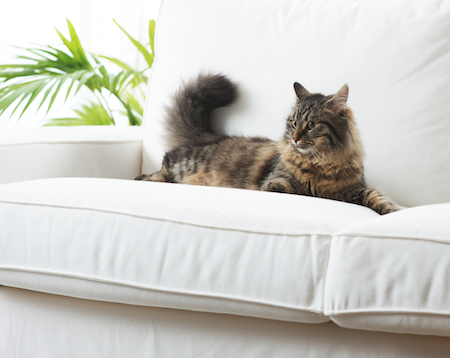
Are hairballs dangerous?
Most hairballs are routine and a regular part of a cat’s life. However, hairballs can cause severe medical conditions with potentially fatal results in some circumstances. A hairball that becomes stuck in the digestive tract can become an intestinal blockage, which quickly becomes a life-threatening situation. Surgical intervention is typically necessary to remove a restrictive blockage. If your cat exhibits any of the following signs of stomach obstruction, contact your veterinarian immediately:
- constipation
- diarrhea
- lack of appetite
- repeated and unproductive gagging retching or hacking
- lethargic behavior
If you notice a change in your cat’s behavior and suspect a hairball obstruction, don’t hesitate to get your cat to an emergency veterinary clinic.
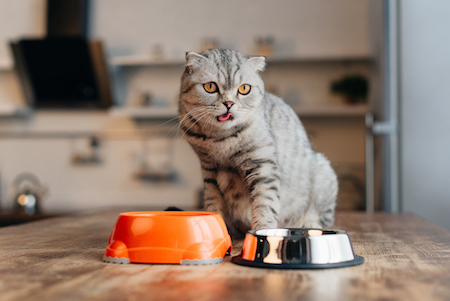
Hairball remedies for your cat
Hairball remedies are available in various forms, so cat parents can exercise treatment options to find the right one for their fussy kitty. Some popular remedies include:
Hairball products
There are many products on the commercial market designed to eliminate hairballs. Many use mild laxatives, usually flavored petroleum jelly, which help lubricate the digestive system. Hence, hairballs pass more easily through it. Gels, soft chews, and pastes are available at any online or brick-and-mortar pet store.
Talk to your vet about the proper dosage of any hairball remedies that you try. A great way to apply petroleum jelly is by squirting it into their mouth, but do not put on paws because they’ll end up greasy and an all-over mess!
Homeopathic remedies
Your veterinarian might have suggestions for natural homeopathic remedies that you can add to your cat’s food. These dietary additions will help ingested hair move through the digestive tract more easily.
Dietary supplements
There are many ways you can lessen the risk of your cat developing hairballs by adding more fiber or fatty acids into their diet. One way is with pet-safe fruits and vegetables, such as pumpkin, which has been shown to help promote healthy digestion. Omega-3 fatty acids can be ingested through fish oil supplements, which many cats thoroughly enjoy.
Hairball formula cat food
Cat parents can buy a cat food brand specifically designed to reduce hairballs. These foods are typically high in fiber and contain fatty acids that assist the digestive system’s efficiency, resulting in fewer hairballs.
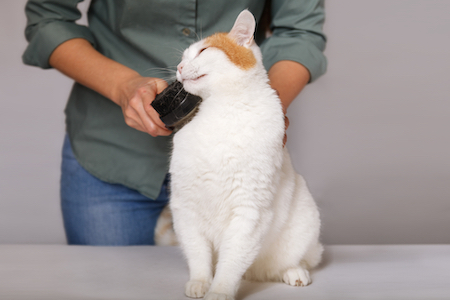
How can you reduce or prevent hairballs in cats?
You can’t stop hairballs from happening, but you might be able to minimize them with the proper preventative measures.
Regular grooming
Indeed, cats are usually good at grooming themselves. Still, frequent brushing can help remove loose hairs and dirt, which might otherwise get swallowed up in their fur and lead to hairballs. Daily brushing is beneficial for older cats and cats with thick or lengthy hair.
Routine veterinary visits
Wondering how to keep your cat from developing hairballs? A checkup with the vet will help. It’s also an excellent time to discuss any concerns or worries you may have about your cat’s grooming habits. Veterinarians also help detect health issues early on when they’re more manageable and more treatable than later down the line.
Interrupt excessive grooming
Too much grooming can lead to hairballs and other serious issues. If you notice your cat spending a lot of time self-grooming and licking their fur, try interrupting those sessions with games and cuddles and quality time with you. Introduce a new toy or treat to distract your cat and interrupt her self-grooming whenever possible.
Feed smaller meals
Try to break up your cat’s feedings into smaller portions to help prevent the buildup of dead hair in their gastrointestinal tract.
Go to a professional groomer.
Professional, adept groomers often take feline clients alongside their typical dogs. Suppose your cat dislikes being brushed at home. In that case, a professional groomer experienced in cleaning and brushing cranky cats is a good bet to take. Often, experienced groomers have access to tools that can take off more dead hair from your cat than the brush you use at home can.
Consider a mobile groomer if your cat is easily stressed riding in a car or being out of the home for an extended period. Your cat will be groomed in the groomer’s van while it’s parked outside of your home and then returned to you immediately. This option may be less stressful for your cat than at a traditional grooming facility.
Try calming tools in the home.
Because stressed and anxious felines tend to self-soothe through excessive grooming, using natural calming products in the home may eliminate this unwanted behavior and the hairballs that come with it. There are many ways you can help your cat feel more at ease. Try giving her treats explicitly designed for calming cats, feeding a prescription diet with ingredients that reduce anxiety, and using calming pheromone plug-ins around the house.
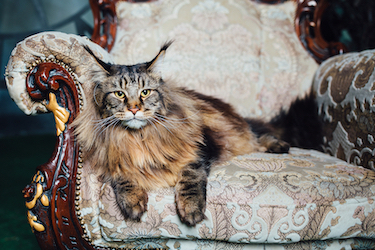
Protect your cat with a pet insurance plan.
Cat hairballs are the realistic price that cat owners pay to have an incredibly unique, loving, and particular feline in their lives. However, the costs to prevent hairballs adds up fast. If surgery is needed for an emergency blockage, you can face bills in the thousands of dollars.
The good news? A pet health insurance plan for your cat will cover up to 90% of emergency care costs, depending on your policy choice. At Pet Insurance Review, we are all about improving the lives of our pets and helping pet parents afford the inevitable emergencies that are part of pet ownership. Prevent hairballs and more today by getting a quick and free insurance quote for your best feline friend.
References:
1. Moss, E. (2019). National Hairball Awareness Day: 10 facts about hairballs. Retrieved from https://www.animeddirect.co.uk/advice/national-hairball-day/#
2. Cassidy, J. (2017). Ever wondered why your cat’s tongue feels like sandpaper? Retrieved from https://www.pbs.org/newshour/science/kqed-deep-look-cats-tongue-sandpaper#
3. Moore, D. (2018). A Zoologist Discusses the Science of Animal Hair. Retrieved from https://www.thegreatcoursesdaily.com/a-zoologist-discusses-what-is-animal-hair/
4. Johnson-Bennett, P. (2022). Why Do Cats Groom so Much? Retrieved from https://catbehaviorassociates.com/why-do-cats-groom-so-much/
5. Cornell University College of Veterinary Medicine. (2016). The Danger of Hairballs. Retrieved from https://www.vet.cornell.edu/departments-centers-and-institutes/cornell-feline-health-center/health-information/feline-health-topics/danger-hairballs
6. Particular Paws. (2019). The Shocking Truth Behind Your Cat’s Hairball Problem. Retrieved from https://www.particularpaws.com/blogs/cat-and-dog-health/the-shocking-truth-behind-your-cats-hairball-problem
7. Modern Cat. (2020). Pumpkin, Your Cat’s Digestive Cure-all. Retrieved from https://moderncat.com/articles/pumpkin-your-cats-digestive-cure-all/
8. Rigley, C. (2021). Tips for Brushing Your Cat and Why You Should. Retrieved from https://www.preventivevet.com/cats/tips-for-brushing-your-cat-and-why-you-should
9. Shojai, A. (2021). Reasons Why Cats Overgroom and How to Stop It. Retrieved from https://www.thesprucepets.com/how-to-stop-cat-over-grooming-554052
10. The Pets About. (2020). 4 Huge Benefits of Hiring a Mobile Pet Groomer. Retrieved from https://thepetsabout.com/4-huge-benefits-of-hiring-a-mobile-pet-groomer/
11. Sinatra, S. (2018). 7 Natural Ways to Ease Cat Anxiety. Retrieved from https://agelesspaws.com/7-natural-ways-to-ease-cat-anxiety/
DisclaimerThe information contained on this blog is intended for informational and educational purposes only and should not be construed as medical advice. It is not a substitute for professional veterinary care. Always consult with your veterinarian before making any changes to your pet's health care or treatment plan.
The authors of this blog are not veterinarians and do not claim to be experts in pet health. The information provided here is based on our own experiences and research, as well as information from reputable sources. However, we cannot guarantee the accuracy or completeness of this information.
We encourage you to do your own research and consult with your veterinarian before making any decisions about your pet's health.
Compare top pet insurance providers plans.
Enter your dog’s age in years and months to calculate their age equivalent to human years.
Calculate your dog’s ageEnter your cat’s age in years and months to calculate their age equivalent to human years.
Calculate your cat’s age